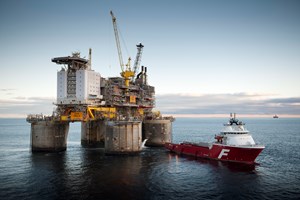Equnior achieves significant CO2 reduction with Troll B and C electrification offshore Norway
(WO) – Earlier this month, Equinor’s Troll B and C fields offshore Norway became partly powered from shore. This reduces annual emissions from the Norwegian Continental Shelf (NCS) by 250,000 tonnes of CO2.
This is in line with the plan for development and operation (PDO) for Troll West electrification (TWEL), which was approved by Norwegian authorities in 2021.
“Troll B and C electrification marks an important milestone in the efforts to halve the emissions from our operations by 2030. The project reduces CO2 emissions by the equivalent of those from 125,000 fossil-fuelled cars,” says Geir Tungesvik, executive vice president for Projects, Drilling & Procurement.
The power to Troll B and C comes from Kollsnes, northwest of Bergen. From here, it runs through a new electro building shared by the Troll and Oseberg fields out to Troll B in a 132 kV power cable, and from there to Troll C.
The project has installed new modules on Troll B and C that adjust the voltage to the systems on board. The processing systems and other energy-intensive systems on both platforms are now driven by electricity, except for the large export compressors, which are still gas-powered.
“Troll West electrification has generated substantial business activity for Norwegian suppliers. Over 70 percent of the investments in the project have gone to companies in Norway. I am very pleased that we, along with our partners and suppliers, have succeeded in executing the project in a safe and effective manner,” Tungesvik says.
The CO2 reduction is equivalent to about half a percent of Norway’s total annual emissions. NOx emissions from the field are also reduced by around 850 tonnes per year. Gas burned in turbines to provide energy on the platforms can now be exported and more efficiently used in Europe.
“We have made several new discoveries in the Troll and Fram area in recent years. Thanks to Troll B and C electrification we can develop and produce these resources with very low emissions. The Troll area will continue to deliver large volumes of low-carbon, high-value energy for many years to come,” says Kjetil Hove, Equinor’s executive vice president for Exploration & Production Norway.
The TWEL project is continuing to fully electrify the Troll C platform so that all power needs are met with electricity from land. The measure will cut annual emissions by another 200,000 tonnes of CO2. Overall, this will help cut almost four percent of the total emissions from oil and gas production, around one percent of total emissions in Norway.
Infrastructure at Kollsnes and the cable to the platform are designed for a possible future full electrification also of Troll B.
The Troll A platform (Troll East) was the first platform to be powered from shore on the NCS, and has been electrified since start-up in 1996.
The licensees in Troll Unit are Equinor 30.6% (operator), Petoro 56%, A/S Norske Shell 8.1%, TotalEnergies 3.7% and ConocoPhillips Skandinavia AS 1.6%.
Aker Solutions AS has built three electro modules at its Stord yard and has been responsible for the procurement and installation of all electrical equipment in the modules and in the new electro building at Kollsnes.
In addition, Aker Solutions has been responsible for all modification work on Troll B and C and all hook-up to existing operating systems both offshore and at Kollsnes.
Total investments in the project are NOK 8.1 billion.



